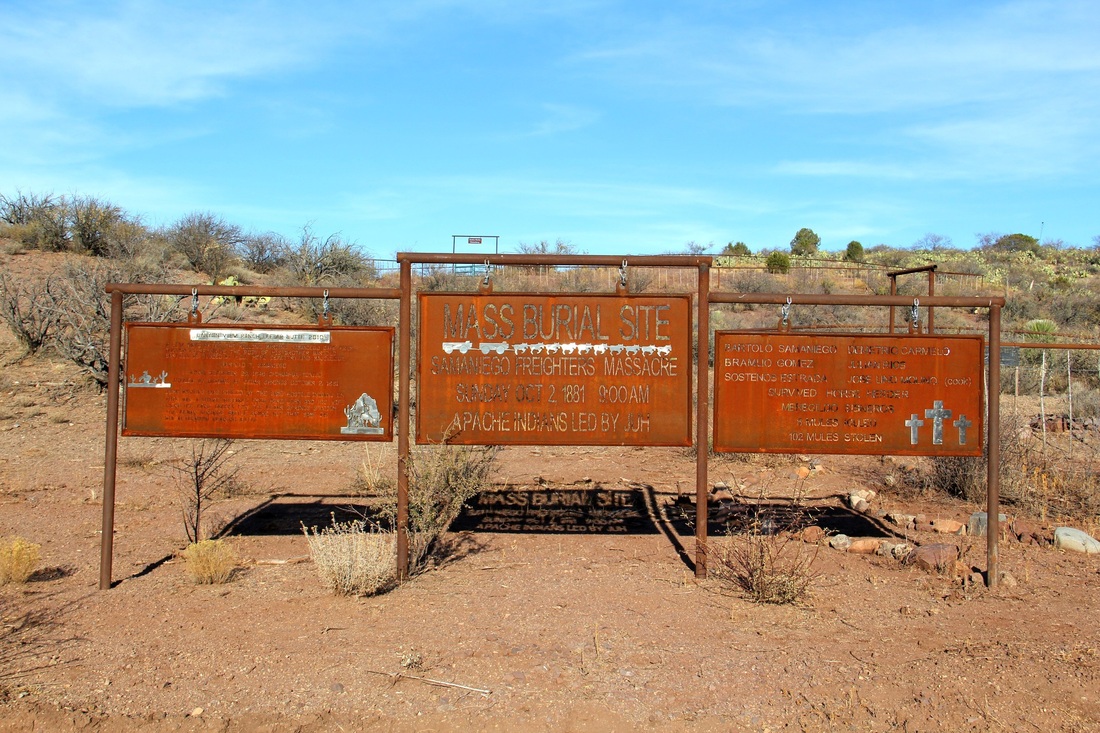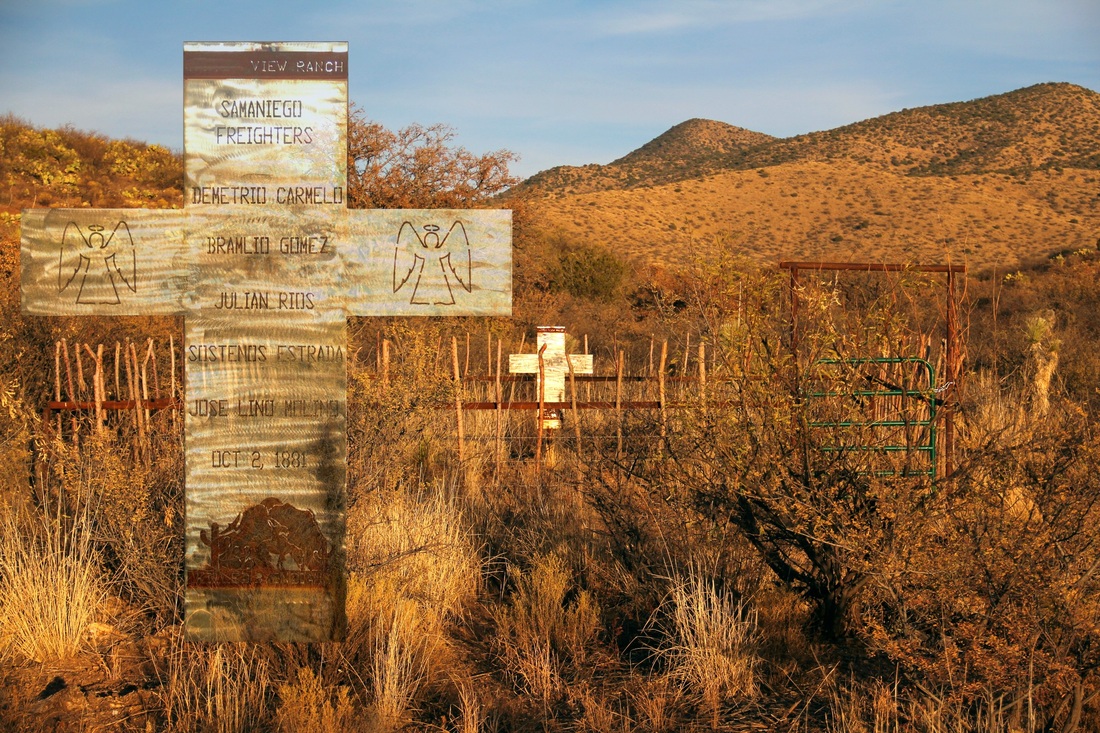Cedar Springs
1881 Apache Outbreak & Samaniego Freight Train Massacre
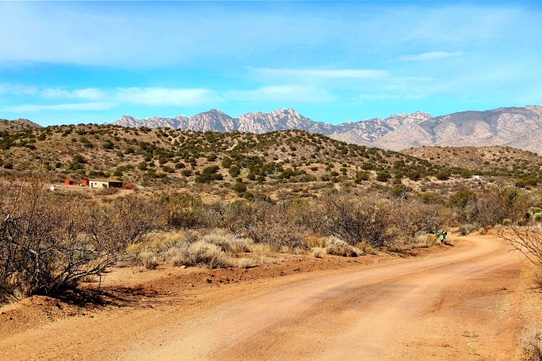
Cedar Springs
Cedar Springs is on Cedar Springs Road (CR 672) Graham County, AZ. About 37 miles from the San Carlos Indian reservation Agency, where the 1881 outbreak started. Located between Fort Grant to the south and Fort Thomas to the north, Cedar Springs Station was on a busy wagon road that was used by the military, as well as businesses and travelers. The road through the area of the spring and massacre site seem to be the same as in 1881.
Cedar Springs Battle was fought that same day about six miles away at K. H. Butte (The Battle at K. H. Butte).
A link to K. H. Butte is at the bottom of the page.
Click it for info on the battle and links to books with in-depth information on both battles.
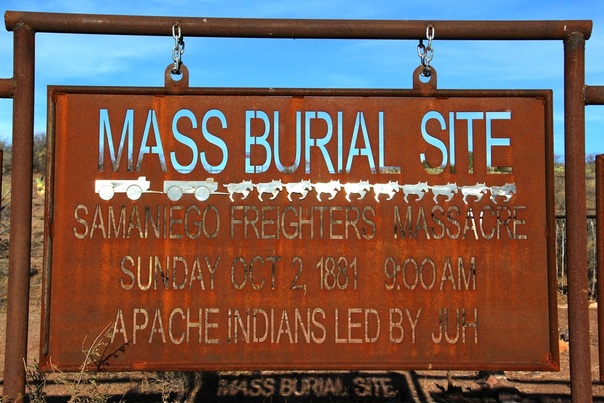
One of the signs put up by the land owner
By the end of 1880 the southern Pacific Railroad line originated in San Francisco and extended to Deming, New Mexico. The following year, the Santa Fe Railroad completed its extension from Albuquerque to Deming and joined the Southern Pacific Line allowing the United States to have its second trans-continental railroad.
In 1881, due to the railroad, the settlement of Wilcox {formerly, Wilcox, with only one ~L in the spelling} was prospering and supplied goods and supplies to numerous military installations and nearby small towns. Wagons pulled by mules and oxen, freight trains, were continuously being loaded at Willcox.
The heavily traveled wagon road which ran North from Willcox to Cedar Springs and around the Pinaleno Mountains to Camp Thomas was 65 miles in distance! This road was not only used for military service but commercial and private travel as well.
The Government had a large contract with Mariano G. Samaniego to deliver Indian supplies to the San Carlos Indian Agency from Willcox. In mid-September he had business matters to tend to in Tucson and left his brother, Bartolo, to complete the loading and delivery of the freight to San Carlos. Bartolo was unable to acquire a military escort as requested by his brother and notified Mariano that he would deliver the goods on his own. Leaving Willcox on September 27th with Bartolo were seven teamsters. The six-team train was quite large; 12 wagons being pulled by 108 mules.
General Willcox was notified of the Chiricahua breakout on October first and also learned that there were three freight trains northbound between Willcox and Fort Thomas on the wagon road. Captain Charles Porter, the Commanding Officer at Fort Grant, was notified by Fort Thomas to ‘please look out for them and see that they are properly guarded to this point.’ Porter was later informed that two of the trains were near Fort Thomas and the other train was near Cedar Springs.
It was Samaniego’s train that was near Cedar Springs! On October 2nd, the following morning, the Chiricahuas attacked the Bartolo and his freighters when they were nearing the Springs. Approaching from the South was General Willcox with an ambulance with four officers traveling ahead of his party.
When they arrived at the Cedar Springs Station, they found Mrs. Mowlds (she was the wife of John Mowlds, the Station Agent at Cedar Springs), Frank Coulter, John Mowlds’ step-son, an Irish-man who had just been passing through, and Meregildo Sisneros (Samaniego’s horse herder) barricaded in the ranch house.
A few days later the four officers recollected what they were told upon their arrival:
All the people united in stating that the Indians [the Chiricahuas] appeared at the station about 10 a.m., that day, chasing the herder of Samaniego’s train, who was in advance of the train hunting for deer on the side hills. The Indians ran him to the station where they observed Samaniego’s train moving towards the station and in plain sight of it. They fired a volley at the station and immediately attacked the train. The men with the train evidently made a brave resistance, for all there united in saying that the Indians were more than an hour in killing them; some say an hour and a half at least.*
*{The Great Escape: The Apache Outbreak of 1881 by Charles Collins; Arizona Weekly Star, October 1, 1881}
It was a concern of the four civilians that they were sure that the Indians remained nearby. Upon arriving at the Station, General Willcox ordered the hostiles to be pursued. A wounded man, shot through the leg, was found about a half mile from the station.
Fifty yards farther [past the wounded man] a man lay dead, and from there to the wagons, 500 yards distant, two more were found dead. By the wagons, another was found shot through the head. Farther down the road, two more lay dead. Out of the seven men with the train, all were killed but one. *
* {Arizona Weekly Star, October 6. 1881}
There was devastation everywhere. All the wagons were ransacked, with the goods scattered about. The flour sacks were cut open and the flour strewn about. There was numerous household goods stolen; cloth, tin-ware, flour, frying pans. The murdered freighters weapons, mostly Winchester rifles, were also taken. One hundred and two mules were stolen, with six mules being killed.
1. Bartolo Samaniego, Mariano’s brother, was killed.
Also murdered were:
2. Carmelo, Demetrio
3. Estrado, Sostenos
4. Gomez, Braulio
5. Molino, Jose Lino (the Cook)
6. Rios, Julian
PARTICULARS OF THE SAMANIEGO MASSACRE.
GRAPHIC ACCOUNT OF THE FIGHT BY A PARTICIPANT~~HOW THE MEN MET THEIR FATE WHILE CHARGING THE HOSTILES.
A STAR reporter yesterday called upon Hon. M.G. Samaniego, who had just returned from the front, and inquired of him concerning the particulars of the massacre of his brother and train men at Cedar Springs, as only a general account of the affair has heretofore been given to the public. The information which we elicited was obtained by him from the herder who escaped the massacre, and from the wounded teamster, who came into Willcox from Camp Grant on Thursday last. The account is as follows: The wagon train had arrived at a little rise of ground, over which all the wagons proceeded except the last one, with which was Mr. B. T. Samaniego. At that moment the Indians were observed about one mile distant, on the plains, and Mr. S. remarked, “I wonder if those Indians are hostile.” The one man who was with him said, “No; they cannot be, or they would not have allowed the woman in the wagon to pass them.“ A woman with her family had just gone along, passing the Indians in safety. She stated that they motioned to her to take another route, and not pass by the train.
After observing the Indians for a few minutes, Mr. S. said to his men, “Go on, boys, I will help the hind team across the rise.” As the wagon was started up a chain broke, which delayed it, and the wagons then became separated, the leading one gaining distance ahead. The drivers of the nearest teams remained to assist the hind wagon. After getting over the difficulty, Mr. S. got on the wagon and sat down with his gun in his lap. Presently the Indians were seen to take positions, nearly surrounding the whole train, when Mr. S. again said to the man with his team, “I wonder if those Indians are hostile?” and just then seeing them open fire on the forward wagon, he said, “Boys, I see they are firing on the front team. Leave your teams and let us go to assist them.”
They then advanced on the run, and succeeded in getting safely to the front, and took a position beneath the wagon, the Indians firing at them meanwhile. They found one man already killed. Another was soon wounded, and as the herder was at a distant point, but three able men were then with Mr. S. The man who was wounded was at the time attempting to fire, when a shell stuck in the gun-barrel and it missed fire. Mr. S. then got into the wagon and procured two handfuls of ammunition, and threw it to those underneath. The four then got into a little rut, almost beneath the wagon, and successfully returned the fire of the Indians for an hour and a half, when Mr. S. finally said, “Boys, there is no use in lying here. We will be killed, anyway. Let us go out and fight them in the open prairie,” intending to force the hostile line at a little rise of ground not far distant.
The teamsters replied, “Boss, if we do that we shall surely get killed.”
Mr. S. replied, “We will get killed anyway; let us go out and fight them like men.”
The teamsters then said they would follow him; when Mr. S. took the lead and they charged out toward the high ground mentioned.
As they advanced, one was killed after the other, Mr. S. falling first, the others in a row as they rushed along ahead of where he lay, except one man, the one who is now at Willcox, and who was shot in the leg and fell, feigning that he was killed. No one flinched in making the charge, and the heroic conduct of Mr. S. was marked and greatly encouraged the others.
The Indians by this time perceived the soldiers, who were advancing, and hastened to destroy the contents of the train, only stopping with the fallen men long enough to take their {cartridge} belts, and having no time to scalp them.
As they were around the wounded man who feigned death, an Indian took his belt, turning him over to do so [using the barrel of his Long tom], and struck him a heavy blow in the back with the butt of his gun, and then rolled him mover again to his first position.
They then turned their attention to the wagons, and destroyed 7,000 pounds of merchandise belonging to Rube Wood, of San Carlos. They killed the animals and cut the harness into many pieces. Portions of the cut harness were afterwards found scattered by them over the country for ten miles, and out of 80 sets, Mr. M. G. Samaniego has not been able to make one complete set.
Had the doomed party remained under the wagon for half an hour longer, they would probably have saved themselves, as the troops, all unknown to them, were rapidly advancing to that point. Or had the herder, who was sent out in advance that morning to hunt for deer, and who came in contact with the hostiles, taken measures to advise them of their danger, they could have made a barricade of flour sacks and thus being prepared, held their own.
The herder had been instructed to hunt along as far as Brewster’s, and there await the train. He saw the Indians about two miles off to the east side of the station at Cedar springs, but did not know they were hostiles, and proceeded on and was soon fired upon by them. He then put spurs to his horse and made for the station where he hastily dismounted and ran around the house in which were a woman, man and boy, leaving his horse at the door. A shot followed him into the building, but hit no one. The Indians charged to the door and drove off his horse and killed it near by, the herder concealing himself in rear of the house and escaping. It is supposed that the Indians did not know of the other parties being in the house, as they did not show themselves, and so they did not come to harm.*
*{Arizona Weekly Star, October 27, 1881}
John F. Finerty, the Chicago Times War Correspondent, visited the scene of the massacre about a week later:
In returning from Camp Thomas to Camp Grant with the detachments of Lieuts. Blake and [Elon F.] Willcox, I had an opportunity of seeing near Cedar Springs, the riddled wagons of Samaniego’s ill-fated train. The Indian fire directed against the half-dozen brave and unfortunate Mexicans, headed by the trainmaster’s young brother, must have been simply infernal. The number of bullet-holes in the vehicles is enormous. It is wonderful, contemplating this fact, how the doomed half-dozen held their own against seventy-five apaches for upward of two hours. The bodies found beside the wagons were full of lead. These men died hard, and the rude cross, in front of “Shot-Gun Smith’s” ranch, that marks the common grave of five of them throw’s its sacred shadow on the dust of heroes. Dead mules pave the roadway, and the grass, trampled all around for miles along the thoroughfare, indicates the desperate nature of the struggle.
The troops did not come up until all the Mexicans but one, who, with splendid presence of mind, feigned death, were dead for some time. The Indians had had leisure to plunder the wagons to a considerable extent before the soldiers made their first appearance. This the Mexican teamster observed as he lay, partially on his face, in the grass. An Indian came up and pounded him with the butt of his gun between the shoulder blades to ascertain if any life was left in him. The Mexican took the pounding and saved his scalp.*
*{Chicago Times, October 21, 1881}
Of interesting note: One of the 102 stolen mules which had Samaniego’s brand was purchased from the estate of Frank McLaury, who was killed during the shoot-out at the O.K. Corral in Tombstone three weeks after the massacre.
In 1881, due to the railroad, the settlement of Wilcox {formerly, Wilcox, with only one ~L in the spelling} was prospering and supplied goods and supplies to numerous military installations and nearby small towns. Wagons pulled by mules and oxen, freight trains, were continuously being loaded at Willcox.
The heavily traveled wagon road which ran North from Willcox to Cedar Springs and around the Pinaleno Mountains to Camp Thomas was 65 miles in distance! This road was not only used for military service but commercial and private travel as well.
The Government had a large contract with Mariano G. Samaniego to deliver Indian supplies to the San Carlos Indian Agency from Willcox. In mid-September he had business matters to tend to in Tucson and left his brother, Bartolo, to complete the loading and delivery of the freight to San Carlos. Bartolo was unable to acquire a military escort as requested by his brother and notified Mariano that he would deliver the goods on his own. Leaving Willcox on September 27th with Bartolo were seven teamsters. The six-team train was quite large; 12 wagons being pulled by 108 mules.
General Willcox was notified of the Chiricahua breakout on October first and also learned that there were three freight trains northbound between Willcox and Fort Thomas on the wagon road. Captain Charles Porter, the Commanding Officer at Fort Grant, was notified by Fort Thomas to ‘please look out for them and see that they are properly guarded to this point.’ Porter was later informed that two of the trains were near Fort Thomas and the other train was near Cedar Springs.
It was Samaniego’s train that was near Cedar Springs! On October 2nd, the following morning, the Chiricahuas attacked the Bartolo and his freighters when they were nearing the Springs. Approaching from the South was General Willcox with an ambulance with four officers traveling ahead of his party.
When they arrived at the Cedar Springs Station, they found Mrs. Mowlds (she was the wife of John Mowlds, the Station Agent at Cedar Springs), Frank Coulter, John Mowlds’ step-son, an Irish-man who had just been passing through, and Meregildo Sisneros (Samaniego’s horse herder) barricaded in the ranch house.
A few days later the four officers recollected what they were told upon their arrival:
All the people united in stating that the Indians [the Chiricahuas] appeared at the station about 10 a.m., that day, chasing the herder of Samaniego’s train, who was in advance of the train hunting for deer on the side hills. The Indians ran him to the station where they observed Samaniego’s train moving towards the station and in plain sight of it. They fired a volley at the station and immediately attacked the train. The men with the train evidently made a brave resistance, for all there united in saying that the Indians were more than an hour in killing them; some say an hour and a half at least.*
*{The Great Escape: The Apache Outbreak of 1881 by Charles Collins; Arizona Weekly Star, October 1, 1881}
It was a concern of the four civilians that they were sure that the Indians remained nearby. Upon arriving at the Station, General Willcox ordered the hostiles to be pursued. A wounded man, shot through the leg, was found about a half mile from the station.
Fifty yards farther [past the wounded man] a man lay dead, and from there to the wagons, 500 yards distant, two more were found dead. By the wagons, another was found shot through the head. Farther down the road, two more lay dead. Out of the seven men with the train, all were killed but one. *
* {Arizona Weekly Star, October 6. 1881}
There was devastation everywhere. All the wagons were ransacked, with the goods scattered about. The flour sacks were cut open and the flour strewn about. There was numerous household goods stolen; cloth, tin-ware, flour, frying pans. The murdered freighters weapons, mostly Winchester rifles, were also taken. One hundred and two mules were stolen, with six mules being killed.
1. Bartolo Samaniego, Mariano’s brother, was killed.
Also murdered were:
2. Carmelo, Demetrio
3. Estrado, Sostenos
4. Gomez, Braulio
5. Molino, Jose Lino (the Cook)
6. Rios, Julian
PARTICULARS OF THE SAMANIEGO MASSACRE.
GRAPHIC ACCOUNT OF THE FIGHT BY A PARTICIPANT~~HOW THE MEN MET THEIR FATE WHILE CHARGING THE HOSTILES.
A STAR reporter yesterday called upon Hon. M.G. Samaniego, who had just returned from the front, and inquired of him concerning the particulars of the massacre of his brother and train men at Cedar Springs, as only a general account of the affair has heretofore been given to the public. The information which we elicited was obtained by him from the herder who escaped the massacre, and from the wounded teamster, who came into Willcox from Camp Grant on Thursday last. The account is as follows: The wagon train had arrived at a little rise of ground, over which all the wagons proceeded except the last one, with which was Mr. B. T. Samaniego. At that moment the Indians were observed about one mile distant, on the plains, and Mr. S. remarked, “I wonder if those Indians are hostile.” The one man who was with him said, “No; they cannot be, or they would not have allowed the woman in the wagon to pass them.“ A woman with her family had just gone along, passing the Indians in safety. She stated that they motioned to her to take another route, and not pass by the train.
After observing the Indians for a few minutes, Mr. S. said to his men, “Go on, boys, I will help the hind team across the rise.” As the wagon was started up a chain broke, which delayed it, and the wagons then became separated, the leading one gaining distance ahead. The drivers of the nearest teams remained to assist the hind wagon. After getting over the difficulty, Mr. S. got on the wagon and sat down with his gun in his lap. Presently the Indians were seen to take positions, nearly surrounding the whole train, when Mr. S. again said to the man with his team, “I wonder if those Indians are hostile?” and just then seeing them open fire on the forward wagon, he said, “Boys, I see they are firing on the front team. Leave your teams and let us go to assist them.”
They then advanced on the run, and succeeded in getting safely to the front, and took a position beneath the wagon, the Indians firing at them meanwhile. They found one man already killed. Another was soon wounded, and as the herder was at a distant point, but three able men were then with Mr. S. The man who was wounded was at the time attempting to fire, when a shell stuck in the gun-barrel and it missed fire. Mr. S. then got into the wagon and procured two handfuls of ammunition, and threw it to those underneath. The four then got into a little rut, almost beneath the wagon, and successfully returned the fire of the Indians for an hour and a half, when Mr. S. finally said, “Boys, there is no use in lying here. We will be killed, anyway. Let us go out and fight them in the open prairie,” intending to force the hostile line at a little rise of ground not far distant.
The teamsters replied, “Boss, if we do that we shall surely get killed.”
Mr. S. replied, “We will get killed anyway; let us go out and fight them like men.”
The teamsters then said they would follow him; when Mr. S. took the lead and they charged out toward the high ground mentioned.
As they advanced, one was killed after the other, Mr. S. falling first, the others in a row as they rushed along ahead of where he lay, except one man, the one who is now at Willcox, and who was shot in the leg and fell, feigning that he was killed. No one flinched in making the charge, and the heroic conduct of Mr. S. was marked and greatly encouraged the others.
The Indians by this time perceived the soldiers, who were advancing, and hastened to destroy the contents of the train, only stopping with the fallen men long enough to take their {cartridge} belts, and having no time to scalp them.
As they were around the wounded man who feigned death, an Indian took his belt, turning him over to do so [using the barrel of his Long tom], and struck him a heavy blow in the back with the butt of his gun, and then rolled him mover again to his first position.
They then turned their attention to the wagons, and destroyed 7,000 pounds of merchandise belonging to Rube Wood, of San Carlos. They killed the animals and cut the harness into many pieces. Portions of the cut harness were afterwards found scattered by them over the country for ten miles, and out of 80 sets, Mr. M. G. Samaniego has not been able to make one complete set.
Had the doomed party remained under the wagon for half an hour longer, they would probably have saved themselves, as the troops, all unknown to them, were rapidly advancing to that point. Or had the herder, who was sent out in advance that morning to hunt for deer, and who came in contact with the hostiles, taken measures to advise them of their danger, they could have made a barricade of flour sacks and thus being prepared, held their own.
The herder had been instructed to hunt along as far as Brewster’s, and there await the train. He saw the Indians about two miles off to the east side of the station at Cedar springs, but did not know they were hostiles, and proceeded on and was soon fired upon by them. He then put spurs to his horse and made for the station where he hastily dismounted and ran around the house in which were a woman, man and boy, leaving his horse at the door. A shot followed him into the building, but hit no one. The Indians charged to the door and drove off his horse and killed it near by, the herder concealing himself in rear of the house and escaping. It is supposed that the Indians did not know of the other parties being in the house, as they did not show themselves, and so they did not come to harm.*
*{Arizona Weekly Star, October 27, 1881}
John F. Finerty, the Chicago Times War Correspondent, visited the scene of the massacre about a week later:
In returning from Camp Thomas to Camp Grant with the detachments of Lieuts. Blake and [Elon F.] Willcox, I had an opportunity of seeing near Cedar Springs, the riddled wagons of Samaniego’s ill-fated train. The Indian fire directed against the half-dozen brave and unfortunate Mexicans, headed by the trainmaster’s young brother, must have been simply infernal. The number of bullet-holes in the vehicles is enormous. It is wonderful, contemplating this fact, how the doomed half-dozen held their own against seventy-five apaches for upward of two hours. The bodies found beside the wagons were full of lead. These men died hard, and the rude cross, in front of “Shot-Gun Smith’s” ranch, that marks the common grave of five of them throw’s its sacred shadow on the dust of heroes. Dead mules pave the roadway, and the grass, trampled all around for miles along the thoroughfare, indicates the desperate nature of the struggle.
The troops did not come up until all the Mexicans but one, who, with splendid presence of mind, feigned death, were dead for some time. The Indians had had leisure to plunder the wagons to a considerable extent before the soldiers made their first appearance. This the Mexican teamster observed as he lay, partially on his face, in the grass. An Indian came up and pounded him with the butt of his gun between the shoulder blades to ascertain if any life was left in him. The Mexican took the pounding and saved his scalp.*
*{Chicago Times, October 21, 1881}
Of interesting note: One of the 102 stolen mules which had Samaniego’s brand was purchased from the estate of Frank McLaury, who was killed during the shoot-out at the O.K. Corral in Tombstone three weeks after the massacre.
GETTING THERE:
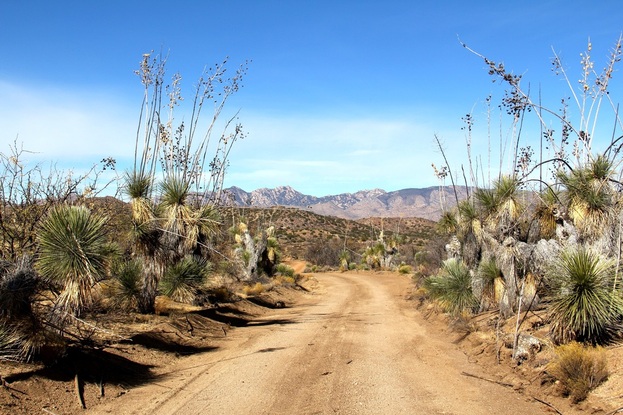
Cedar Springs Road
From Willcox, AZ
Exit #340 off interstate 10 onto Fort Grant Road heading west (this road runs west and north).
Turn left onto Bonita Aravaipa Road.
Right onto Klondyke Road, not sure if there's a sign or not so here's the GPS coordinates
N 32 45.964 W 110 14.396
Right onto Cedar Springs Road (Co. Road 672).
N 32 49.657 W 110 09.180
Cedar Springs N 32 46.631 W 110 08.998
The Spring is accessible to everyone, but the massacre and burial site is on private property.
A car with good tires should be fine for this trip as most the roads were better than the one I live on.
Exit #340 off interstate 10 onto Fort Grant Road heading west (this road runs west and north).
Turn left onto Bonita Aravaipa Road.
Right onto Klondyke Road, not sure if there's a sign or not so here's the GPS coordinates
N 32 45.964 W 110 14.396
Right onto Cedar Springs Road (Co. Road 672).
N 32 49.657 W 110 09.180
Cedar Springs N 32 46.631 W 110 08.998
The Spring is accessible to everyone, but the massacre and burial site is on private property.
A car with good tires should be fine for this trip as most the roads were better than the one I live on.
The above site is on PRIVATE PROPERTY and you MUST HAVE PRIOR PERMISSION from the property owner.
WHAT YOU"LL SEE:
K H Butte
For additional information: 'The Great Escape: The Apache Outbreak of 1881' by Charles Collins, Copyright 1994, Westernlore Press, Tucson, Arizona.
Home
